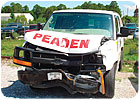
The study, based on data from the time period of September 2005 through August 2006, focused on vehicles with a gross vehicle weight rating (GVWR) of less than 16,000 pounds and trucks, or vehicles with a GVWR of more than 16,000 pounds. Light local vehicles insured on a commercial policy include passenger cars, pickup trucks, SUVs, vans and minivans, etc., and trucks include tractor-trailers, dump and tow trucks, flatbeds, etc.
Chris Homewood, commercial auto product manager, said the study was not designed to find out why crashes occurred, rather, to learn from accident trends. “Our claims data simply show when crashes happen, not why,” he said.
“However, we release this data to help commercial auto customers better understand various commercial auto trends, and how they could be impacted. We believe that the more informed people are about insurance the better, and hope that the data will help drivers lessen their risk of being involved in accidents.”
WHAT THE STUDY REVEALED
The study showed that Fridays were not very good for drivers of light commercial vehicles:• Most crashes involving light local vehicles happened on Fridays, while the least number of crashes happened on Tuesdays and Mondays (Saturdays and Sundays were excluded from the study).
• Crashes involving heavier trucks happened most often on Thursdays and least often on Mondays and Fridays.
The winter months had an impact on the study, too:
• In the study period, December 2005 had the highest rate of accidents involving light local vehicles insured by Progressive Commercial Auto. The month with the second highest was November 2005. The months with the lowest rate of accidents were January and April 2006. The difference be-tween highest and lowest? The likelihood of light local vehicles being involved in a crash was 17 percent greater in December 2005 than in January 2006.
• June 2006 had the highest rate of accidents involving trucks, which was 29 percent greater than the month with the lowest, January 2006.
The study showed that there was a correlation between the time a vehicle was on the road and the number of crashes that occurred:
• About 66 percent of all crashes involving light local and heavier trucks happened during traditional work hours, though most of the crashes involving heavier trucks happened between 6 a.m. and 5 p.m. And those involving light local vehicles started one hour later from 7 a.m. to 6 p.m.
• Light local vehicles were involved in the most crashes be-tween 12 p.m. and 6 p.m., while heavier trucks were involved in most of their crashes between 11 a.m. and 4 p.m.
Homewood noted that his company has not used this data to compare with other years but he added that Progressive believes that sharing the information can lead to a better understanding of insurance rates.
“We collect this data - and lots of other data - in the course of accurately pricing commercial auto policies and thought it was interesting, so we are sharing it and using it as an opportunity to let business owners know that insurance is more than just shopping around for the lowest rate, it’s also about service,” he said.
HVAC CONTRACTORS GET INSURANCE TIPS
While this data cannot prevent business owners from the inevitability of accidents, it can make them aware of the likelihood of accidents and to promote awareness among its employees.“As an HVAC contractor, you should review your policy and/or speak to an independent agent to be sure that your business vehicles, including all attached business equipment and anyone who may be driving the vehicle while on the job, are properly covered,” he said. “HVAC contractors should know how the policy is priced because they can control some of their insurance costs. “Insurance companies generally price to cover the cost of future accidents. To do this, they use information about businesses, their vehicle(s) and their driving history, along with historical claims information.”
Here are some tips Homewood suggested for controlling commercial auto insurance costs:
•Driving history influences rates.HVAC business owners should run Motor Vehicle Reports (MVRs) on potential hires. Ask your agent for help with this. While a Commercial Driver’s License (CDL) may not be required in your state to operate your vehicle(s), you may find that drivers who have them are more skilled.
•Proof of prior insurance is important.Never let your insurance lapse; if you do, you most certainly will pay more for your next policy.
•Ask your agent about discounts.There are a lot of them out there, including paid-in-full and renewal discounts.
•Credit.Some insurance companies use information about your credit history in helping to determine your rate. Ask your agent specifically what information each company looks at so that you understand what’s influencing your premium - positively and negatively.
“A combination of competitive rates, specialized coverages, and claims handling provide the protection and fast, accurate estimates that ensure drivers get back on the road, and back to work, as quickly as possible,” Homewood said.
For more information, visit www.progressivedirect.com.
Publication Date:07/16/2007



